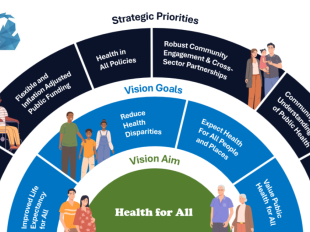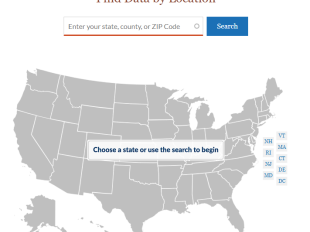Improving health through community organizing
In uncertain political times, public health and health care practitioners may wonder how to best use their power to improve health and equity. Some experts agree: Strategies combining community organizing and public health can work to improve health for everyone.
When people come together for a shared purpose, build relationships, identify collective issues, and use strategies and tactics to achieve goals, they’re engaging in community organizing. What Works for Health’s new strategy, community organizing in public health, outlines this partnership’s potential to improve health and equity. Community organizing in public health may increase public health effectiveness, according to recent reviews by Kadariya et al (2023) and Jimenez and Heller (2025). Experts also suggest that community organizing has the potential to increase community power and social connectedness and to decrease health disparities.
Collaborative efforts or use of community organizing methods can improve physical and mental health outcomes in communities. For example, communities may have increased access to health information and research findings because of community organizing initiatives. And public health practitioners and researchers may shift priorities and agendas in response to community organizing partnerships or methods, toward greater focus on communities and equity. Both sectors can draw on each other’s networks, as well as form new relationships and coalitions, which may support feelings of belonging and connectedness. Experts add that inter-organizational networks can be powerful in a globalized context — and suggest that success in recent public health initiatives is in part related to increased community participation and organizing — with community trust and local leadership as key components.
Community organizers have long drawn attention to unfair resource distribution and unsafe conditions in communities, at times with support from public health. Policy wins to improve housing, address environmental and occupational health hazards, and to advance labor and disability rights demonstrate the strength of continued efforts to bridge community organizing and public health. To learn from implementation examples across North America, including from Indigenous communities, visit the strategy’s implementation section.
CHR&R has additional resources that feature community organizing, including a blog that highlights community organizing wins in Minnesota and challenges the public health field to reflect on the possibilities that can be achieved through community organizing. We also recently released a podcast series exploring the power of organizing to improve our health, diving into public health’s history of organizing around just causes and the ways it can return to its powerful, political roots.
Narratives for Health, an initiative led by CHR&R and Human Impact Partners, helps organizations accelerate change for health, equity and racial justice by embedding transformative narratives in their work. This year, they named partnering with community organizers as one of two key strategies that will guide the future of public health work. Learn more here.
References:
Kadariya, S., Ball, L., Chua, D., Ryding, H., Hobby, J., Marsh, J., Bartrim, K., Mitchell, L., & Parkinson, J. (2023). Community organising frameworks, models, and processes to improve health: A systematic scoping review. International Journal of Environmental Research and Public Health, 20(7), 5341.
Jimenez, C., Heller, J.C. (2025). Community organizing and public health: A rapid review. BMC Public Health. 25(1):669.


